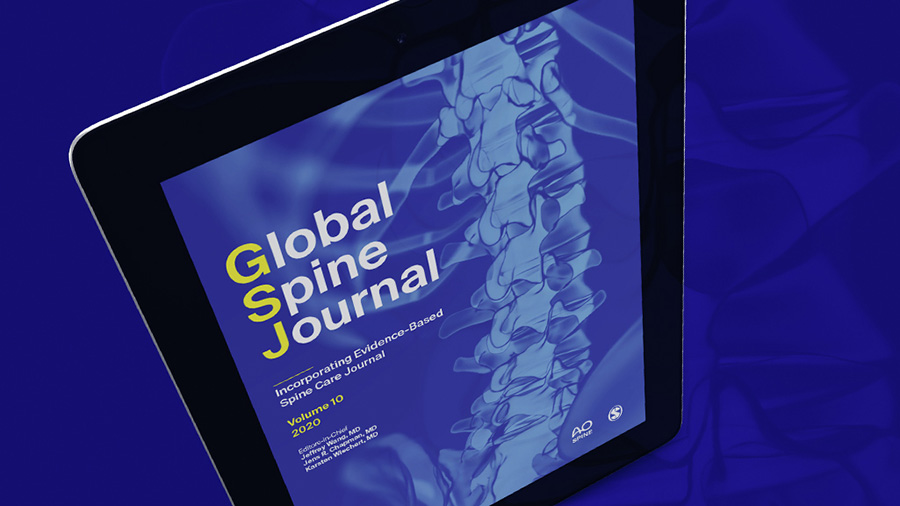Understanding the connection between gut health and Lumbar Degenerative Spondylolisthesis
BY DR DINO SAMARTZIS

In recent years, there has been a growing number of studies into how the gut microbiome influences a range of medical conditions from arthritis to mental health. Now, a new study has found that gut health may also be a factor when it comes to spinal degeneration:
Disclaimer: The article represents the opinion of individual authors exclusively and not necessarily the opinion of AO or its clinical specialties.
Lumbar Degenerative Spondylolisthesis (LDS) is a painful spinal condition involving the gradual breakdown of spinal discs and joints, leading to vertebrae slipping out of alignment. This misalignment can create spinal instability, causing pain and often requiring surgery in severe cases.
LDS predominantly affects people over 50, with women more commonly impacted than men. The lower spine, particularly between the fourth and fifth vertebrae (L4-L5), is usually the most affected. Though various factors such as age, diet, and bone density are thought to influence LDS, its exact causes remain unclear.
Another potential, yet so far under-researched, factor is the gut microbiome. The human gut hosts trillions of microorganisms that support digestion, immunity, and overall health. When this microbiome becomes imbalanced (a condition called dysbiosis), it can trigger inflammation and has been associated with various health issues, from digestive disorders to diabetes and mental health conditions. Emerging research also suggests that gut dysbiosis may play a role in musculoskeletal diseases such as osteoporosis and certain forms of arthritis. However, gut dysbiosis and its link to spine health is not well understood.
Microbial diversity and lumbar spine degeneration
It was for this reason that we set up a multi-disciplinary study at the Rush University Medical Center in Chicago ,involving experts from many fields – including geneticists, spine surgeons, gastroenterologists, and rheumatologists among many others. This study aimed to explore whether there are distinct differences in gut microbiome composition between individuals with LDS and those without, and if such differences could be linked to the development of this spinal condition. By examining the gut bacteria profiles of symptomatic patients with and without LDS, we hoped to uncover patterns that might suggest a connection between gut health and spinal degeneration.
The study involved 33 subjects, 36.4% of whom did not have LDS and 63.6% of whom did. There were 19 males and 14 females (a higher proportion of the female subjects had LDS even though this is not statistically significant.) Also, no noticeable differences were observed in BMI, smoking or alcohol consumption between subjects and pain and disability scores didn’t different between the LDS and non-LDS groups.
We collected various samples such as disc tissue from surgeries, blood, saliva, and stool samples. We asked patients undergoing surgery to provide stool samples beforehand, and to complete various questionnaires. The stool samples, in particular, were essential because they allowed us to analyze the genetic signatures of bacteria in the gut. With current technology, we can now identify and differentiate the levels of specific bacteria in the gut, helping us understand how these bacteria might relate to spinal conditions.
Gut dysbiosis and LDS
Despite the relative smallness of the research cohort, there were some very striking findings and observations that certainly merit further investigation.
- There is a connection between disc degeneration and increased gut microbial diversity in LDS patients
The study found that patients with LDS showed a higher degree of disc degeneration compared to those without LDS. Additionally, these patients exhibited a more diverse gut microbiome, specifically in "alpha diversity," which measures the variety of different bacterial species present. This diversity was significantly greater in the LDS group than in the non-LDS group.
- There are distinct microbial patterns in LDS patients
Analyzing the structure of gut bacteria populations (beta diversity), researchers observed notable differences between the LDS and non-LDS groups. LDS patients had a distinct pattern in their gut microbiome composition, suggesting that certain bacterial groups may be associated with this spinal condition.
- LDS patients displayed a higher Firmicutes-to-Bacteroidota Ratio
A striking finding was that LDS patients had a significantly higher ratio of bacteria from the phylum Firmicutes compared to those from the phylum Bacteroidota, commonly referred to as the Firmicutes-to-Bacteroidota (F/B) ratio. This ratio has been linked to various inflammatory and metabolic conditions in other research. A higher F/B ratio may promote inflammation, which could potentially contribute to the progression of spinal degeneration observed in LDS.
- There is a higher-level of pro-inflammatory bacteria in LDA patients
At the genus level, the study identified specific bacterial groups that differed significantly between LDS and non-LDS patients. LDS patients had higher levels of bacteria known for promoting inflammation, such as Dialister and a group called CAG-352. Conversely, they had lower levels of bacteria that generally help reduce inflammation, such as Slackia and Escherichia-Shigella. This imbalance between pro- and anti-inflammatory bacteria may influence spinal health by creating a more inflammatory environment in the body.
- Age and Body Mass Index (BMI) were not contributing factors
Although age and BMI are known to influence gut microbiome diversity, the study controlled for these factors and found that the differences in bacterial communities between LDS and non-LDS patients remained statistically significant. This indicates that the gut microbiome's association with LDS may be independent of these common factors.
The possibility of a ‘gut-spine’ axis for spinal issues
The findings suggest a potential "gut-spine axis," where an imbalance in gut bacteria could contribute to the development of spinal conditions such as LDS. This study is groundbreaking in its identification of a distinct gut microbiome profile in LDS patients, emphasizing a higher prevalence of pro-inflammatory bacteria and an elevated F/B ratio. Such findings open up new possibilities for understanding how gut health may influence spinal degeneration and the chronic inflammation associated with it.
We hope research could pave the way for future studies exploring whether targeting gut health might help prevent or slow the progression of LDS. For example, interventions such as probiotics or dietary changes designed to reduce inflammation might benefit those at risk of developing LDS or other degenerative spine conditions.
This study builds on existing research linking gut dysbiosis to diseases beyond the digestive system. Dysbiosis has been connected to conditions as diverse as asthma, obesity, rheumatoid arthritis, and neurodegenerative disorders. The “leaky gut” theory is one proposed mechanism where a weakened gut barrier allows inflammatory molecules to enter the bloodstream, potentially affecting distant organs, including the spine. Gut health may also affect how an individual metabolizes medications, which could explain why some people respond well to certain medications, while other people don’t, especially in the context of back pain.
There is also growing evidence suggesting that gut bacteria can influence bone health. Certain bacteria can affect bone density, and studies have shown that conditions like osteoporosis and some types of arthritis are associated with specific bacterial profiles. Similarly, the gut-brain axis demonstrates how gut bacteria can influence mental health through immune and hormonal pathways. The gut-spine axis suggested by this study is an intriguing addition to the expanding understanding of how gut health impacts the entire body.
While this study provides valuable insights, it also has limitations. One challenge in microbiome research is high individual variability, meaning that each person’s gut microbiome is unique and can be influenced by many factors such as diet, genetics, and lifestyle. Additionally, the study's small sample size may limit the generalizability of its findings. Further research with larger participant groups could provide more definitive conclusions.
The study also relied on 16S rRNA gene sequencing, a method that identifies bacteria at the genus level but lacks specificity at the species level. Future studies could use more advanced sequencing techniques to gain a more detailed understanding of which bacterial species are involved in LDS.
The need for further research into LDA and the gut microbiome
Moreover, while the study found an association between gut dysbiosis and LDS, it could not establish causation. Longitudinal studies that follow patients over time would be needed to determine whether changes in gut bacteria precede the onset of LDS, or if gut dysbiosis is a consequence of spinal degeneration. Future research might also explore whether interventions aimed at modifying the gut microbiome can influence the progression of LDS.
This pioneering study highlights a potential link between gut microbiome composition and lumbar degenerative spondylolisthesis, suggesting that gut dysbiosis may play a role in spinal degeneration. LDS patients were found to have a distinct gut bacterial profile characterized by a higher abundance of pro-inflammatory bacteria and a greater Firmicutes-to-Bacteroidota ratio.
Our next ambition is to develop an international consortium focused on the microbiome as it relates to spine health and disease (there are other sites and centers that are also doing similar studies). In an ideal world, we would love to collaborate, pool resources, and establish some kind of standardization for how data is collected, and analyzed. There’s always strength in numbers, especially if we want to generalize findings to other populations, which would exponentially increase the impact of any study.
Setting up an international network could also be useful in the development of a treatment in future. There’s work to be done on microbiome fecal transplantation, for example. We could eventually introduce a specific cocktail, capsule, or tablet focused on balancing the gut microbiome, making it healthier or more stable.
While further research is needed to confirm these findings and explore causal relationships, this study at least lays the groundwork for considering gut health as a factor in spinal health. In the future, addressing gut dysbiosis could become a part of managing or preventing degenerative spinal conditions, offering new pathways for treatment, personalized healthcare strategies and even predictive modelling.
About the author:
Dr Dino Samartzis is a Professor in the Department of Orthopedic Surgery at Rush University Medical Center in Chicago, Illinois. He also serves as the Director of the International Spine Research and Innovation Initiative (ISRII) at Rush.
Samartzis earned his undergraduate degree from Northwestern University. He pursued graduate studies in biological sciences, evidence-based health care, clinical epidemiology, medical sciences, and international studies at institutions including Harvard University, the University of Oxford, the University of Cambridge, Erasmus University, Charles University, and the London School of Economics and Political Science. He completed a postdoctoral fellowship in the Department of Biochemistry at The University of Hong Kong. He is the recently elected research chair for AO Spine’s International Research Commission.
The author would also like to acknowledge the contributions of Khaled Aboushaala, Ana V. Chee, Darbaz Adnan, Sheila J. Toro, Harmanjeet Singh, Andrew Savoia, Ekamjeet S. Dhillon, Catherine Yuh, Jake Dourdourekas, Ishani K. Patel, Rajko Vucicevic, Alejandro A. Espinoza-Orias, John T. Martin, Chundo Oh, Ali Keshavarzian, Hanne B. Albert, Jaro Karppinen, Mehmet Kocak, Arnold Y. L. Wong, Edward J. Goldberg, Frank M. Phillips, Matthew W. Colman, Frances M. K. Williams, Jeffrey A. Borgia, Ankur Naqib, Stefan J. Green, Christopher B. Forsyth, and Howard S. An.
References and further reading:
- Aboushaala K, Chee AV, Adnan D et al [2024] Gut microbiome dysbiosis is associated with lumbar degenerative spondylolisthesis in symptomatic patients. JOR Spine 7(4):e70005.
You might also be interested in:
Making your patients and practice flourish
The AO Knowledge Forum Review articles published in the Global Spine Journal (GSJ) streamline the journey of research into clinical practice and help busy clinicians stay up to date with latest evidence.
AO-GO Guideline for osteobiologics
The AO Spine Guideline for the use of osteobiologics (AO-GO) in Anterior Cervical Discectomy and Fusion (ACDF) for spinal degenerative cases helps clinicians navigate the complex field.
Knowledge Forum Degenerative
Helping surgeons to make the best choice—increasing awareness of evidence through exciting and innovative projects to understand and treat degenerative spinal disorders.





